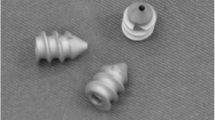Abstract
The most common cervical abnormality associated with rheumatoid arthritis (RA) is atlantoaxial subluxation, and atlantoaxial transarticular screw fixation has proved to be one of the most reliable, stable fixation techniques for treating atlantoaxial subluxation. Following C1–C2 fixation, however, subaxial subluxation reportedly can bring about neurological deterioration and require secondary operative interventions. Rheumatoid patients appear to have a higher risk, but there has been no systematic comparison between rheumatoid and non-rheumatoid patients. Contributing radiological factors to the subluxation have also not been evaluated. The objective of this study was to evaluate subaxial subluxation after atlantoaxial transarticular screw fixation in patients with and without RA and to find contributing factors. Forty-three patients who submitted to atlantoaxial transarticular screw fixation without any concomitant operation were followed up for more than 1 year. Subaxial subluxation and related radiological factors were evaluated by functional X-ray measurements. Statistical analyses showed that aggravations of subluxation of 2.5 mm or greater were more likely to occur in RA patients than in non-RA patients over an average of 4.2 years of follow-up, and postoperative subluxation occurred in the anterior direction in the upper cervical spine. X-ray evaluations revealed that such patients had a significantly smaller postoperative C2–C7 angle, and that the postoperative AA angle correlated negatively with this. Furthermore, anterior subluxation aggravation was significantly correlated with the perioperative atlantoaxial and C2–C7 angle changes, and these two changes were strongly correlated to each other. In conclusion, after atlantoaxial transarticular screw fixation, rheumatoid patients have a greater risk of developing subaxial subluxations. The increase of the atlantoaxial angel at the operation can lead to a decrease in the C2–C7 angle, followed by anterior subluxation of the upper cervical spine and possibly neurological deterioration.





Similar content being viewed by others
References
Agarwal AK, Peppelman WC, Kraus DR, Pollock BH, Stolzer BL, Eisenbeis CH Jr et al (1994) Recurrence of cervical spine instability in rheumatoid arthritis following previous fusion: Can disease progression be prevented by early surgery? J Rheumatol 19:1364–1370
Arnett FC, Edworthy SM, Bloch DA, McShane DJ, Fries JF, Cooper NS et al (1988) The American Rheumatism Association 1987 revised criteria for the classification of rheumatoid arthritis. Arthritis Rheum 31:315–324
Clarke MJ, Cohen-Gadol AA, Ebersold MJ, Cabanela ME (2006) Long-term incidence of subaxial cervical spine instability following cervical arthrodesis surgery in patients with rheumatoid arthritis. Surg Neurol 66:136–140
Dreyer SJ, Boden SD (1999) Natural history of rheumatoid arthritis of the cervical spine. Clin Orthop Relat Res 366:98–106
Eleraky MA, Masferrer R, Sonntag VK (1998) Posterior atlantoaxial facet screw fixation in rheumatoid arthritis. J Neurosurg 89:8–12
Gallie WE (1939) Fractures and dislocations of the upper cervical spine. Am J Surg 46:495–499
Gluf WM, Schmidt MH, Apfelbaum RI (2005) Atlantoaxial transarticular screw fixation: a review of surgical indications, fusion rate, complications and lessons learned in 191 adult patients. J Neurosurg Spine 2:155–163
Haid RW Jr, Subach BR, McLaughlin MR, Rodts GE Jr, Wahlig JB Jr (2001) C1–C2 transarticular screw fixation for atlantoaxial instability: a 6-year experience. Neurosurgery 49:65–68
Hamilton JD, Johnston RA, Madhok R, Capell HA (2001) Factors predictive of subsequent deterioration in rheumatoid cervical myelopathy. Rheumatology 40:811–815
Ito H, Neo M, Fujibayashi S, Miyata M, Yoshitomi H, Nakamura T (2008) Atlantoaxial transarticular screw fixation with posterior wiring using polyethylene cable: facet fusion despite of posterior graft resorption in rheumatoid patients. Spine 33:1655–1661
Kato Y, Itoh T, Kanaya K, Kubota M, Ito S (2006) Relation between atlantoaxial (C1/2) and cervical alignment (C2–C7) angles with Magerl and Brooks techniques for atlantoaxial subluxation in rheumatoid arthritis. J Orthop Sci 11:347–352
Kraus DR, Peppelman WC, Agarwal AK, DeLeeuw HW, Donaldson WF III (1991) Incidence of subaxial subluxation in patients with generalized rheumatoid arthritis who have had previous occipital cervical fusions. Spine 16:S486–S489
Magerl F, Seeman PS (1987) Stable posterior fusion of the atlas and axis by transarticular screw fixation. In: Kehr P, Werdner PA (eds) Cervical spine I. Springer, Vienna, pp 322–327
Matsunaga S, Sakou T, Onishi T, Hayashi K, Taketomi E, Sunahara N et al (2003) Prognosis of patients with upper cervical lesions caused by rheumatoid arthritis: comparison of occipitocervical fusion between c1 laminectomy and nonsurgical management. Spine 28:1581–1587
Mukai Y, Hosono N, Sakaura H, Fujii R, Iwasaki M, Fuchiya T et al (2007) Sagittal alignment of the subaxial cervical spine after C1–C2 transarticular screw fixation in rheumatoid arthritis. J Spinal Disord Tech 20:436–441
Naderi S, Crawford NR, Song GS, Sonntag VK, Dickman CA (1998) Biomechanical comparison of C1–C2 posterior fixations. Cable, graft, and screw combinations. Spine 23:1946–1955
Neo M, Matsushita M, Iwashita Y, Yasuda T, Sakamoto T, Nakamura T (2003) Atlantoaxial transarticular screw fixation for a high-riding vertebral artery. Spine 28:666–670
Neo M, Fujibayashi S, Miyata M, Takemoto M, Nakamura T (2008) Vertebral artery injury during cervical spine surgery. Spine 33:779–785
Neo M, Sakamoto T, Fujibayashi S, Nakamura T (2005) A safe screw trajectory for atlantoaxial transarticular fixation achieved using an aiming device. Spine 30:E236–E242
Shen FH, Samartzis D, Jenis LG, An HS (2004) Rheumatoid arthritis: evaluation and surgical management of the cervical spine. Spine J 4:689–700
White AP, Biswas D, Smart LR, Haims A, Grauer JN (2007) Utility of flexion-extension radiographs in evaluating the degenerative cervical spine. Spine 32:975–979
Yonezawa T, Tsuji H, Matsui H, Hirano N (1995) Subaxial lesions in rheumatoid arthritis: radiographic factors suggestive of lower cervical myelopathy. Spine 20:208–215
Yoshimoto H, Ito M, Abumi K, Kotani Y, Shono Y, Takeda T et al (2004) A retrospective radiographic analysis of subaxial sagittal alignment after posterior C1–C2 fusion. Spine 29:175–181
Acknowledgments
No funds were received in support of this work. No benefits in any form have been or will be received from a commercial company related directly or indirectly to the subject of this manuscript.
Author information
Authors and Affiliations
Corresponding author
Rights and permissions
About this article
Cite this article
Ito, H., Neo, M., Sakamoto, T. et al. Subaxial subluxation after atlantoaxial transarticular screw fixation in rheumatoid patients. Eur Spine J 18, 869–876 (2009). https://doi.org/10.1007/s00586-009-0945-5
Received:
Revised:
Accepted:
Published:
Issue Date:
DOI: https://doi.org/10.1007/s00586-009-0945-5




